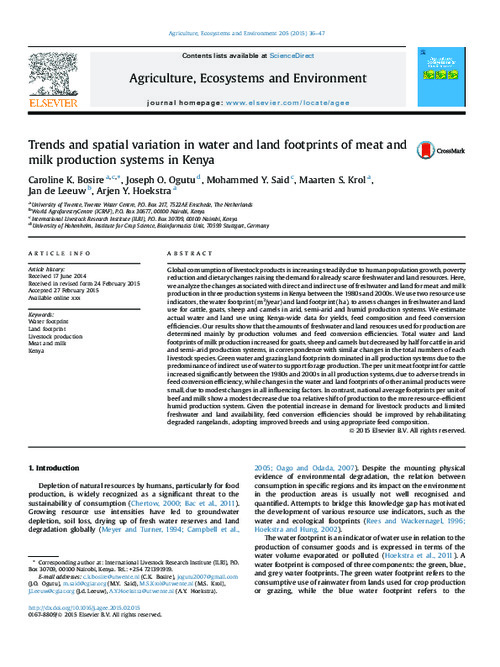Trends and spatial variation in water and land footprints of meat and milk production systems in Kenya
Abstract
Global consumption of livestock products is increasing steadily due to human population growth, poverty
reduction and dietary changes raising the demand for already scarce freshwater and land resources. Here,
we analyze the changes associated with direct and indirect use of freshwater and land for meat and milk
production in three production systems in Kenya between the 1980s and 2000s. We use two resource use
indicators, the water footprint (m3/year) and land footprint (ha), to assess changes in freshwater and land
use for cattle, goats, sheep and camels in arid, semi-arid and humid production systems. We estimate
actual water and land use using Kenya-wide data for yields, feed composition and feed conversion
efficiencies. Our results show that the amounts of freshwater and land resources used for production are
determined mainly by production volumes and feed conversion efficiencies. Total water and land
footprints of milk production increased for goats, sheep and camels but decreased by half for cattle in arid
and semi-arid production systems, in correspondence with similar changes in the total numbers of each
livestock species. Green water and grazing land footprints dominated in all production systems due to the
predominance of indirect use of water to support forage production. The per unit meat footprint for cattle
increased significantly between the 1980s and 2000s in all production systems, due to adverse trends in
feed conversion efficiency, while changes in the water and land footprints of other animal products were
small, due to modest changes in all influencing factors. In contrast, national average footprints per unit of
beef and milk show a modest decrease due to a relative shift of production to the more resource-efficient
humid production system. Given the potential increase in demand for livestock products and limited
freshwater and land availability, feed conversion efficiencies should be improved by rehabilitating
degraded rangelands, adopting improved breeds and using appropriate feed composition

